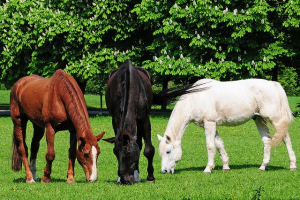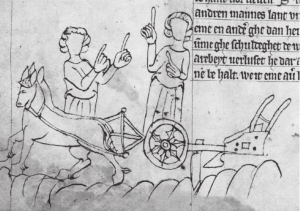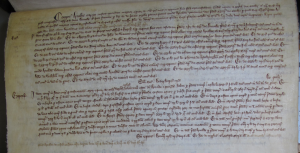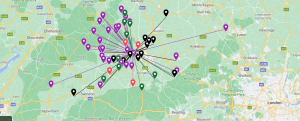FEEDING ENGLAND’S ROYAL HORSES IN THE FOURTEENTH CENTURY
Dr Gary Baker
A few months ago I wrote a blog looking at how England’s stock of medieval warhorses were managed: MANAGING ENGLAND’S ROYAL WARHORSES IN THE FOURTEENTH CENTURY | Warhorse (exeter.ac.uk). This month I look in more detail at how English monarchs kept their horses provisioned, and the administrative machinery behind that process.

An army marches on its stomach, so the saying goes, and what is true of people is equally applicable to animals. Medieval horses, just like their present-day counterparts, were used for a variety of different tasks. Indeed, in the Middle Ages the use of horses was far more widespread than it is today, with horses employed in a whole multitude of tasks from agricultural work to war. Whatever their intended function, horses require a large number of calories to stay healthy and perform their duties. A typical horse eats between 2–2.5% of their bodyweight as dry forage per day, but this varies depending on age and workload. A modern horse undertaking ‘heavy work’ such as racing will need somewhere in the region of 30,000 calories per day. Clearly this is at the top end of nutritional requirements for horses bred for peak physical performance. Nevertheless, even horses utilised in less strenuous physical activities require a substantial amount of fodder. The majority of this can be met through grazing for horses ‘at rest’ or employed in light work, but grazing alone cannot meet all of the calorific and nutritional needs for the majority of horses.
The accounts of England’s royal warhorses provide a huge corpus of information about the provisioning of the king’s elite horses. The specifics of each royal stud and stable vary based upon location, particularly the availability, and quality, of pasture for grazing. Nevertheless, in general terms, we are able to detect patterns in the accounts. Many, if not all of the royal studs were within, or adjacent to, royal parks and manors, and the horses were pastured and grazed within them during the spring and summer, with additional sustenance provided by royal officials. In the colder winter months however, these officials – the keepers of the studs and stables and the grooms they employed to maintain the animals – provided the horses with the majority of their food. The major fodder provided to the animals were oats, hay, straw, and cut grass, with the occasional mention of other foodstuffs like bran, beans, peas, and ‘horse bread’, a mixture of grains and ground legumes. The amount provided for each animal depended on its age and type, but ascertaining exactly how much is tricky. The amounts of hay, cut grass, straw, and horse bread, are not provided in the accounts, only the expense of buying them. Even the more expensive foodstuffs, the quantities of which are provided in the accounts, are difficult to ascertain with certainty, as they are measured in quarters, bushels, and other often unfamiliar terms. The bushel, for example, was a measure of volume varying in weight from less than 25lbs to as much as 50lbs, and 8 bushels comprised 1 quarter.
Nevertheless it is possible to provide approximations of horses intakes from the information in the documents. Unsurprisingly it was the destriers, the elite male warhorses, which received the lion’s share of the food. At a conservative estimate this amounted to a half to two-thirds of a bushel of oats per day (c.12lbs per day with the half bushel), but this could be as much as two bushels, such as was provided for 3 stallions at Eastwood in October 1294. This meant that if fed only a half bushel every day, a destrier would consume 91¼ bushels (or just under 11½ quarters at 8 bushels the quarter) per year. This was far more than the average medieval carthorse at around 0.2 bushels per day, and triple the amount of the average medieval plough horse at c.1–4 quarters per year. It has thus been calculated that if destriers were also receiving more hay and other foodstuffs than other horses, then the destrier may well have been as much as 400–500lbs heavier than the average medieval horse. Colts received considerably less in oats per day than destriers, whilst mares and fillies seem to have received no oats at all, instead being fed largely on hay and straw.

An illuminated manuscript from the German ‘Sachsenspiegel’ law code (early 14th century). Horses used for agriculture required far less food than warhorses.
Large quantities of these foodstuffs had to be purchased for each animal at considerable expense. The account of Arnold Garcy, Keeper of the king’s ‘great horses’ (a catch-all term applied to a variety of different types of animal) from 26 October 1330 to 15 December 1331 is illustrative of the level of this expense. Arnold’s account records a total expense for the account of £783 3s 8½d for as many as 112 horses: destriers, coursers, hobbies, and Arnold’s own horse. Of this amount, a total of £524 2s 6¼d was spent directly on food for the horses: £145 19s 1½d on hay; £352 16s 8¼d on 1561 quarters and 3 pecks of oats and 46 quarters and 5½ bushels of bran and an unspecified amount of horse bread; £11 15s 10d of cut grass for the horses in the summertime; and £13 10s 10½d on straw. In other words, two thirds of all Arnold’s expenses for the period were for feeding the horses under his care.

Detail from the account of Arnold Garcy, Keeper of the King’s Great Horses, 26 October 1330 – 15 December 1331 (TNA E372/176 f. 63v).
These foodstuffs were acquired from a variety of sources local to the stables for which they were required, though sometimes they were brought via water, especially to those studs and stables in Oxfordshire from which large quantities of foodstuffs were shipped up the River Thames from London. The scale of the logistical operation of supplying a royal stable can be mapped thanks to rolls of provisions compiled by the keepers of horses, showing to whom they still owed money for the fodder they had been supplied. The map below shows the provisioning network for a single royal stable in the village of Eynsham in West Oxfordshire, from 12 January – 6 April 1344, with the locations which supplied the stable with oats (purple), beans and peas (green), straw (pink), and hay (black).

The map shows just how extensive these provisioning networks were, though more research is needed into whether or not the presence of the king’s horses in a stable was a burden on the locality, draining it of much needed foodstuffs, or a boon, providing income and jobs for those in the locality.